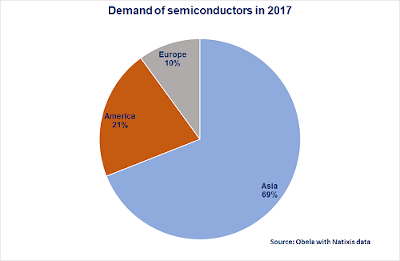The importance of chips in commercial warfare
- blog de anegrete
- 3168 lecturas
In the context of the current trade war, the US has two main advantages over China: the dollar as the world currency, and much of the dominance in the microprocessor industry, through Intel, AMD and Qualcomm, as mentioned before (http://obela.org/analisis/el-corazon-de-la-guerra-comercial). The dominance of semiconductors is important in the trade war, as it is a strong point for the U.S. and on which China depends. China has important strategic advantages, such as telecommunications with the 5G network, where Huawei leads the world. Trump, through the allegation of "national security" seeks to limit these advantages with limited success, as evidenced by the boycott of the range of services of Google and Android with respect to Huawei from May 20191.

For the Chinese economy, a leading producer of computers, electric cars, smartphones and other mobile devices, the importation of semiconductors as inputs is a fundamental aspect. The trade war restrictions on integrated circuits are stifling Chinese industry, while at the same time opening the door to create their own semiconductor industry.
The global semiconductor industry is concentrated in a few firms and a few countries. Although the manufacturing link in the semiconductor chain is in Asia, licensing, intellectual property and the productive segments of the semiconductor value chain do not pass through China. TSMC in Taiwan, which builds the processors for Apple and Huawei, is particularly noteworthy. The company is at the forefront of processor manufacturing, while the design is owned by US companies Intel, AMD and Qualcomm2, and Korea's Samsung.
The continent with the highest demand for semiconductors as an input to its electronics industry is Asia, mainly China, which imports 30% of global exports of this type, mostly from Taiwan, Korea and other Asian countries3.
Current Chinese microprocessors continue to be relegated from the forefront of American firms; even so, China's dependence on integrated circuits is thought to be temporary. The Asian country has begun work towards the autonomy of chip manufacturing, which can be consolidated using reverse engineering. This is already beginning to bear fruit. A Zhaoxin4 processor can already offer the performance of an Intel i5-7400, a seventh-generation processor, which is still far back from the most recent generation5. However, this shows that the Chinese process is on the right track.
Intel, and to a lesser extent Qualcomm and AMD, have the world's largest market share in processor manufacturing and design, a strategic advantage for the United States in the trade war. However, the Chinese semiconductor company, Hygon and AMD have established an agreement, where the former opens the market using AMD-owned Zen architecture. Hygon will produce processors virtually identical to the original AMD; therefore, it is an apparent door to reverse-engineering to ensure that Chinese processors will be at the forefront in the future.

Robert Spalding, former director of strategic planning for the U.S. National Security Council6, called the act "handing over the keys to the kingdom”7. Some business specialists believe that joint ventures are being used to transfer technology, taking advantage of spaces to circumvent U.S. restrictions8. Some other media, clarify that there is endorsement of the U.S. government itself for the joint partnership with China and that the delivery of technology is a relatively archaic core, not the vanguard of 7nm9 that are the keys to the kingdom and that AMD will not share10 .
Although China does not yet hold the keys to the kingdom, the partnership with AMD is a significant step in reverse engineering, understood as a process. It is inevitable that the Asian country will develop an autonomous and competitive semiconductor industry and thus diminish its backwardness vis-à-vis the United States. So it is, that it will achieve it in a short time. For the United States, this means losing one of its few strategic advantages in the commercial war. It would be necessary to wait "5 to 10 years" 11according to Zhou Zhiping of the University of Beijing, although, from the evidence, surely it will be in less time.
1 https://www.xataka.com/legislacion-y-derechos/google-dejara-colaborar-huawei-futuros-telefonos-huawei-no-tendran-google-play-otras-apps-reuters
2 https://www.xataka.com.mx/celulares-y-smartphones/que-ganar-carrera-7-nm...
3 Data from OEC MIT referred to integrated circuits in general
4 https://www.profesionalreview.com/2019/06/23/kx-6000-zhaoxin-core-i5-7400/
5 The Zhaoxin processor has eight cores, 16nm, with approximately 3Ghz frequency. The tenth generation of Intel offers from 4.1 to 4.8 Ghz approximately.
6 https://www.af.mil/About-Us/Biographies/Display/Article/999629/brigadier...
7 Words of the Gen. Robert Spalding about giving up x86 technology, a fundamental point in the leadership of AMD and Intel.
8 https://www.wsj.com/articles/u-s-tried-to-stop-china-acquiring-world-cla...
9 Refers to the size of transistors in nanometers. 7 nanometers is the size of transistors that allows the highest performance in the market.
10 https://wccftech.com/no-amd-did-not-sell-keys-kingdom-how-thatic-jv-works/
11 https://www.scmp.com/tech/tech-leaders-and-founders/article/3024315/chin...